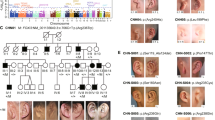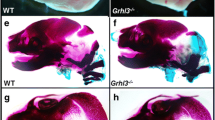Abstract
Inherited defects of skull ossification often manifest as symmetric parietal foramina (PFM; MIM 168500). We previously identified mutations of MSX2 in non-syndromic PFM and demonstrated genetic heterogeneity1. Deletions of 11p11–p12 (proximal 11p deletion syndrome, P11pDS; MIM 601224; ref. 2) are characterized by multiple exostoses, attributable to haploinsufficiency of EXT2 (refs. 3,4) and PFM. Here we identify ALX4, which encodes a paired-related homeodomain transcription factor, as the PFM disease gene in P11pDS.


Similar content being viewed by others
References
Wilkie, A.O.M. et al. Nature Genet. 24, 387– 390 (2000).
Bartsch, O. et al. Am. J. Hum. Genet. 58, 734– 742 (1996).
Stickens, D. et al. Nature Genet. 14, 25– 32 (1996).
Wuyts, W. et al. Hum. Mol. Genet. 5, 1547– 1557 (1996).
McGaughran, J.M., Ward, H.B. & Evans, D.G.R. J. Med. Genet. 32, 823– 824 (1995).
Wuyts, W. et al. Eur. J. Hum. Genet. 7, 579– 584 (1999).
Kutilek, S., Baxova, A., Bayer, M., Leiska, A. & Kozlowski, K. J. Paediatr. Child Health 33, 168–170 (1997).
Salamanca, A. et al. Prenat. Diagn. 14, 766– 769 (1994).
Qu, S., Li, L. & Wisdom, R. Gene 203, 217–223 ( 1997).
Hudson, R., Taniguchi-Sidle, A., Boras, K., Wiggan, O. & Hammel, P.A. Dev. Dyn. 213, 159–169 (1998).
Takahashi, M. et al. Development 125, 4417– 4425 (1998).
Qu, S. et al. Development 124, 3999–4008 (1997).
Qu, S. et al. Development 125, 2711–2721 (1998).
Wu, Y.-Q. et al. Am. J. Hum. Genet. 67, 1327– 1332 (2000).
Iseki, S., Wilkie, A.O.M. & Morriss-Kay, G.M. Development 126, 5611– 5620 (1999).
Acknowledgements
We thank the families for cooperation; R. Wisdom for the Alx4 probe; N. Elanko and S. Twigg for technical support; K. Clark for DNA sequencing; J. Peden, the OUBC group and the HGMP-RC for computing support; and P. Anslow for radiological expertise. This work was funded by the Alexander S. Onassis Foundation (Greece) and Medical Research Council (UK) (L.A.M.), The Anatomical Society of Great Britain and Ireland (I.A., G.M.M.-K.), Action Research (G.M.M.-K.) and the Wellcome Trust (A.O.M.W.).
Author information
Authors and Affiliations
Corresponding author
Supplementary information
Rights and permissions
About this article
Cite this article
Mavrogiannis, L., Antonopoulou, I., Baxová, A. et al. Haploinsufficiency of the human homeobox gene ALX4 causes skull ossification defects. Nat Genet 27, 17–18 (2001). https://doi.org/10.1038/83703
Received:
Accepted:
Issue Date:
DOI: https://doi.org/10.1038/83703
- Springer Nature America, Inc.
This article is cited by
-
Methylation as a critical epigenetic process during tumor progressions among Iranian population: an overview
Genes and Environment (2021)
-
Disruption of PHF21A causes syndromic intellectual disability with craniofacial anomalies, epilepsy, hypotonia, and neurobehavioral problems including autism
Molecular Autism (2019)
-
Genome-wide detection of copy number variation in Chinese indigenous sheep using an ovine high-density 600 K SNP array
Scientific Reports (2017)
-
Runs of homozygosity reveal signatures of positive selection for reproduction traits in breed and non-breed horses
BMC Genomics (2015)
-
Solution NMR structures of homeodomains from human proteins ALX4, ZHX1, and CASP8AP2 contribute to the structural coverage of the Human Cancer Protein Interaction Network
Journal of Structural and Functional Genomics (2014)





